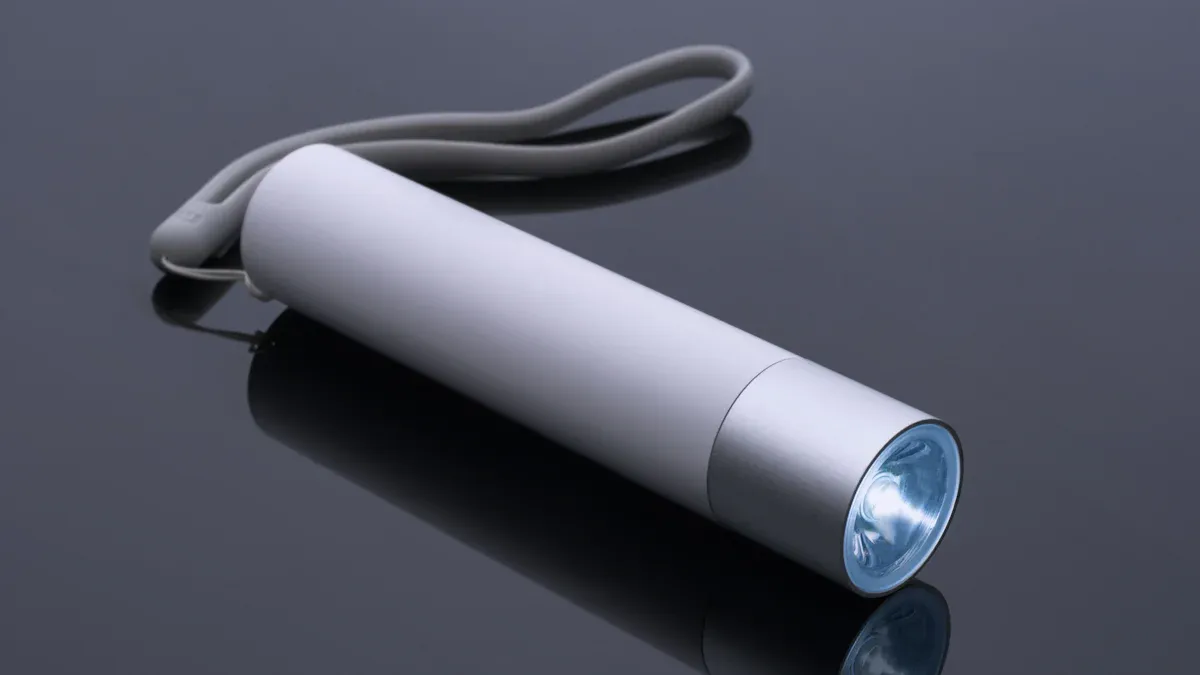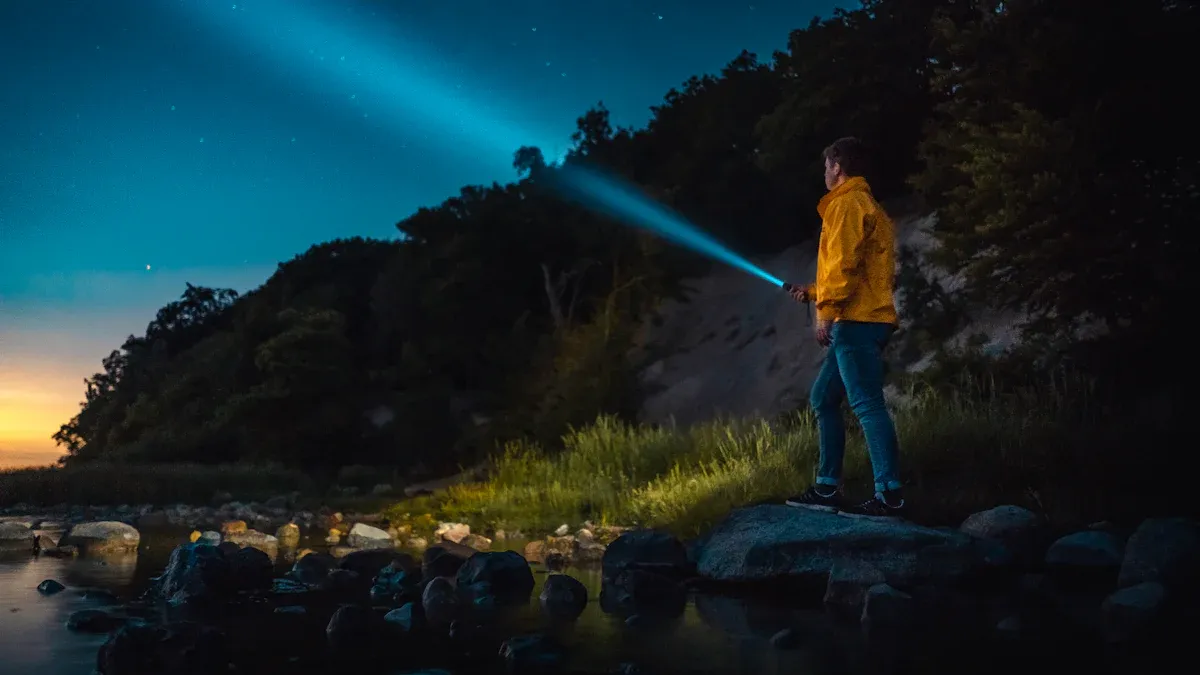How to Ensure Your Flashlight Remains Waterproof for Outdoor Use

A waterproof flashlight is essential for rugged outdoor use. It ensures reliability in wet conditions, whether you're camping, hiking, or fishing. Without proper care, water can damage internal components, leading to failure. Regular maintenance preserves durability, making your helius flashlight a quick easy waterproof flashlight solution for unpredictable weather and challenging environments.
Key Takeaways
Learn about IP ratings to pick the best flashlight. Higher ratings like IPX7 or IPX8 mean better water protection.
Check seals and O-rings often for any damage. Replace broken parts to keep your flashlight waterproof.
Clean your flashlight after using it to avoid dirt buildup. Store it in a cool, dry spot to make it last longer.
Understanding Waterproof Ratings

What Are IP Ratings for Flashlights?
IP ratings, or Ingress Protection ratings, measure how well a flashlight resists dust and water. These ratings follow international standards like IEC 60529 and ANSI, ensuring consistency across products. The IP rating consists of two digits. The first digit indicates protection against solid particles, while the second digit shows water resistance. For example, an IPX4 rating means the flashlight can handle splashes from any direction, while IPX7 allows submersion in water up to one meter for 30 minutes.
When choosing a waterproof flashlight for rugged outdoor use, understanding these ratings is crucial. They help you determine whether your flashlight can withstand the conditions you plan to face, such as rain, splashes, or even submersion.
How IP Ratings Define Waterproof Performance
IP ratings directly correlate with a flashlight's real-world performance. Lower ratings like IP44 or IP54 offer basic protection against splashes, making them suitable for light rain. Higher ratings like IP65 or IP67 provide better water resistance. For instance, IP65 flashlights resist water jets, while IP67 models can survive temporary immersion. If you need a flashlight for extreme conditions, IP68-rated devices are ideal as they can handle continuous submersion beyond one meter.
These ratings ensure your flashlight performs reliably in wet environments, whether you're hiking in heavy rain or kayaking through rough waters.
Choosing the Right IP Rating for Outdoor Use
Selecting the right IP rating depends on your activities. For light rain or occasional splashes, an IPX4 flashlight suffices. If you expect heavy rain or water jets, opt for IPX6. For activities like kayaking or fishing, an IPX7 flashlight offers peace of mind with its submersion capability. For underwater exploration, an IPX8-rated flashlight is the best choice.
A quick easy waterproof flashlight with the appropriate IP rating ensures durability and reliability in challenging conditions. Always match the rating to your specific needs for optimal performance.
Practical Steps to Maintain a Waterproof Flashlight
Inspecting Seals and O-Rings for Damage
Seals and O-rings are critical for maintaining your flashlight's water resistance. Regular inspection ensures they remain effective. Start with a visual check. Look for cracks, tears, or flattened areas on the O-ring. Next, perform a physical test by stretching or compressing the O-ring to assess its elasticity. If it feels brittle or deformed, replace it immediately. You can also conduct a simple leakage test. Submerge the O-ring in water and apply pressure. Watch for bubbles, as they indicate potential leaks. These steps help you identify issues early, ensuring your flashlight stays waterproof.
Cleaning Your Flashlight After Outdoor Use
Cleaning your flashlight after rugged outdoor use is essential for maintaining its performance. Follow these steps:
Remove the batteries to prevent accidental activation.
Wipe the exterior with a soft, lint-free cloth. For stubborn dirt, use a slightly damp cloth.
Clean the threads and apply a thin layer of silicone-based lubricant to keep them smooth.
Use a microfiber cloth or lens cleaning solution to remove dirt and fingerprints from the lens.
Inspect the battery compartment for debris or corrosion. If needed, clean it with a cotton swab dipped in vinegar or lemon juice.
These steps ensure your flashlight remains in top condition.
Storing Your Flashlight to Prevent Moisture
Proper storage protects your flashlight from moisture and extends its lifespan. Always store it in a cool, dry place away from direct sunlight. Humidity can cause internal corrosion, especially in the battery compartment. Use a protective case or pouch to shield it from dust and impacts. By sealing the back end securely, you can further prevent moisture from entering. These practices keep your flashlight ready for your next adventure.
Features of a Reliable Waterproof Flashlight

Importance of Durable Materials
The materials used in a flashlight significantly impact its performance and longevity. High-quality waterproof flashlights often feature anodized aluminum or stainless steel casings. These materials resist corrosion, making them ideal for wet environments. Rubber seals and gaskets further enhance water resistance by preventing leaks.
Material | Durability Characteristics | Notes |
|---|---|---|
Aluminum | Less shock absorbent, can deform permanently under stress | Used in premium flashlights for heat dissipation and a solid feel. |
Plastic | Absorbs shock better, less prone to permanent deformation | More stable over time but can melt under extreme temperatures. |
Anodized aluminum and reinforced plastics are also common in shockproof flashlights. Aluminum adds strength without excessive weight, while rubberized coatings absorb shock and protect internal components. These durable materials ensure your flashlight withstands rugged outdoor conditions.
Role of O-Rings and Gaskets in Waterproofing
O-rings and gaskets play a crucial role in maintaining water resistance. Rubber rings create a barrier against moisture, preventing water from entering the flashlight. Different rubber types offer varying levels of water vapor barrier properties, making them essential for watertight seals.
You can enhance waterproofing by using extra O-rings or applying a thin lubricant to maintain their suppleness. However, avoid heavy-bodied grease, as it may degrade the O-ring over time. Regularly inspect these components to ensure they remain effective. A well-maintained O-ring system keeps your flashlight waterproof and reliable.
Impact Resistance and Its Contribution to Waterproofing
Impact resistance is another vital feature of a reliable waterproof flashlight. Manufacturers design these flashlights to endure drops and impacts, ensuring they perform in challenging conditions. Materials like anodized aluminum and reinforced plastics contribute to both waterproofing and shock resistance.
For example, manufacturers test impact resistance by dropping flashlights from 1.2 meters onto concrete or using drum roller drop testing. These methods ensure the flashlight can handle rugged use without compromising its waterproof capabilities. A flashlight with excellent impact resistance and build quality offers durability and reliability in extreme environments.
Maintenance Tips for Long-Term Waterproof Performance
Regular Checks for Wear and Tear
Inspecting your flashlight regularly helps you catch early signs of wear and tear. Focus on areas like the seals, O-rings, and casing. Look for cracks, scratches, or any signs of damage that could compromise water resistance. Pay attention to the lens and threads as well. Dirt or corrosion in these areas can reduce the flashlight's performance. A quick visual check before and after outdoor use ensures your flashlight stays in top condition. Consistent maintenance also extends its durability, making it reliable for future adventures.
Replacing Worn or Damaged Components
Replacing damaged parts is essential for maintaining your flashlight's waterproof features. Start by checking the O-rings and gaskets. If they appear brittle or lose elasticity, replace them immediately. Use manufacturer-recommended parts to ensure compatibility and maintain water resistance. The battery compartment is another critical area. Corroded terminals can affect the flashlight's functionality. Clean them or replace the batteries as needed. Regularly updating worn components keeps your flashlight's build quality intact and ensures long-term reliability.
Avoiding Prolonged Submersion in Water
Even waterproof flashlights have limits. Avoid prolonged submersion to prevent unnecessary stress on seals and internal components. Follow these best practices:
Clean your flashlight after each use to remove dirt and debris.
Store it in a cool, dry place to protect it from moisture damage.
Remove the batteries when not in use to prevent corrosion.
These steps help maintain water resistance and ensure your helius flashlight performs reliably in wet conditions. Proper care preserves its durability and extends its lifespan.
Understanding IP ratings helps you choose a flashlight that meets your needs, whether for rainstorms or underwater use. Consistent care, like inspecting seals and cleaning, ensures long-term waterproof performance. Prioritize durable features, such as sealed casings and impact resistance, to maintain reliability. A well-maintained waterproof flashlight guarantees dependable outdoor use.
FAQ
How do you test if your flashlight is still waterproof?
Submerge it in shallow water for a few minutes. Check for leaks or moisture inside. Always inspect seals and O-rings before testing.
Can you use any lubricant on O-rings?
No, only use silicone-based lubricants. Other types can degrade the rubber, reducing the flashlight's waterproof performance and compromising its reliability.
What should you do if water enters your flashlight?
Remove the batteries immediately. Dry the flashlight thoroughly with a soft cloth. Inspect seals and replace damaged components to restore waterproof functionality.
See Also
Key Strategies for Keeping Your Flashlight Functional
Designed for Longevity: Our Emergency Flashlight's Strength
Selecting the Ideal Color Flashlight for Outdoor Adventures
